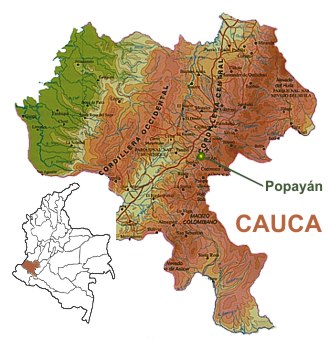 CAUCA
Inhabitant: Caucano
CAUCA
Inhabitant: Caucano
This department was created in 1886,
It has an area of 29,308 square kilometres, 80 per cent of which is
covered by a mountainous region.
Part of the so-called
Masizo Colombiano is
located in Cauca, where the Western and Central
cordilleras
(mountain ranges) are divided and where the rivers of Magdalena, Cauca,
Caquetá and Patía originate.
Cauca borders the departments of Valle del Cauca,
Tolima, Huila Caquetá, Putumayo, Nariño and the Pacific
Ocean.
It is a land of remarkable landscapes such as the
Natural National Park of Puracé, with lakes, hot springs and
waterfalls.
Before the conquest, the department was populated by
different native tribes. The Guambianos and the Pijaos were the most
important. Some of them survive today and live in protected regional
areas.
Sebastián de Belelazar was the first Spaniard to
arrive on these lands, where he founded the city of Popayán.
At present Cauca has nearly 1,345,000 inhabitants.
Fifty six per cent of its population is formed by white and racially
mixed people that live in the central part of the department. Native
communities in the eastern region of Tierradentro represent the 21 per
cent of its population. Descendants of black Africans on the Pacific
coast form another 23 per cent Cauca's inhabitants.
Agriculture is Cauca's main economic strength. The
department is Colombia's second biggest sugar-cane producer. Corn,
yucca, banana, coffee, wheat, rice, bean, tobacco, potatoes and cocoa
are also important crops. Livestock and industry (mainly pulp and paper)
are other sources of income.
Capital: Popayán
Popayán, the "Stately city of Colombia" was founded by
Sebastián de Belalcázar in 1537 at the foot of the
Puracé volcano. Its original name was Asunción de
Popayán. It has approximately 250,000 inhabitants, who are proud
of their culture and aristocratic ancestry.
This city has been the cradle of the heroes of our Independence,
prominent writers and illustrious politicians.
With pretty colonial-style white houses and buildings, the city itself
could be considered as a monument to its past. An earthquake destroyed
many of Popayán's buildings in 1983, but they have since been
reconstructed.
Popayán is an important religious center with beautiful churches
such as the Cathedral of Popayán called Our Lady of the
Assumption, the church of San Francisco, the church of El Carmen, the
churches of La Encarnación, San José, Santo Domingo, San
Augustín, and the Chapel of Belén. La Ermita, the city's
first church, was built in 1546.
The Museum of Religious Art houses many pieces of incalculable artistic
value, such as a collection of gold and precious stones, paintings and
sculptures. Other places worth visiting are the Museum of Art of Edgar
Negret, the Museum Martínez, the House of Valencia, the House of
Mosquera, the Bridge of the Humilladero, the Tower of El Reloj, El Morro
de Tulcán and the Monasterio Hotel. The University of Cauca, the
Colegio Mayor, the University Antonio Nariño and the Cooperative
University are important educational centres.
The city's most important event is the celebration of the Holy Week.
Thousands of pilgrims from across Colombia attend every year. The city
of Popayan was appointed the first UNESCO City of Gastronomy in the year
2005.